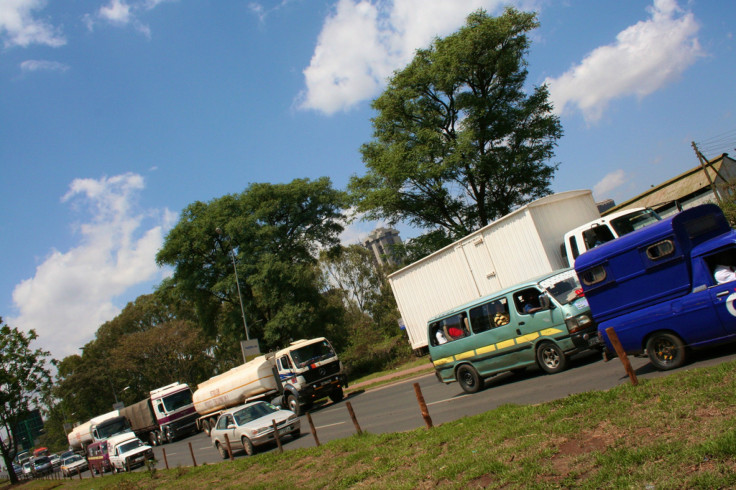In Nairobi, A Brand New Commuter Train To Beat Kenya’s Worst Traffic Jams

Nairobi's traffic is legendary.
Roads and avenues in this capital city of Kenya are typically bumper-to-bumper with cars, trucks, vans and motorbikes. On the busiest streets, fumes pollute the air and horns blare in a constant cacophony.
The most recent Commuter Pain Survey, a global study released by IBM, ranked Nairobi the world’s fourth-worst city for traffic (just after Beijing, whose population is nine times larger). Nairobi had the ignominy of beating out such mega-cities as New Delhi, New York, London and Los Angeles.
People in the suburb of Syokimau deal with this problem every day. Those who drive into Nairobi for work might take Mombasa road, or A109, an old highway that reaches all the way to the eastern coast and has gained a reputation as one of the deadliest motorways in the country. Close to the capital, rush-hour traffic moves like molasses. The 10-mile journey from Syokimau to Nairobi can take up to two hours.
But now, for the first time ever, those commuters will have another option.
A new rail line was inaugurated Tuesday. It will go from a sparkling, state-of-the-art station in Syokimau to a platform in central Nairobi. Passengers can get a one-way ticket for about US$2.50. Kenyan President Mwai Kibaki was on board for the train’s first official trip into the capital, and paying passengers stepped on afterwards for a ride back to the suburbs.
According to the Kenya-based newspaper Business Daily, six trains will make five round trips each on a daily basis, mostly during rush hour. The Kenya Railways Commission, which developed the new line as a joint project with the UK-based donor-funded enterprise InfraCo Limited, estimates that the trains will accommodate about 20,000 riders every day, which will work wonders to ease congestion on some of Nairobi’s busiest roads.
The new station at Syokimau is a pretty big deal, too. It is the first commuter exchange to be built since the nation’s independence in 1963. It’s got all the bells and whistles, including automated ticket purchasing and up-to-the-minute scheduling alerts.
The new construction comes just days after the initiation of a similar project in neighboring Tanzania. There, in the fast-growing port city of Dar es Salaam, the country's very first municipal commuter rail was kicked off on Oct. 29. That system was a triumph for Tanzania, one of the poorest countries on earth. There, as in many countries not only in East Africa but all across the continent, infrastructural projects can be both a result and a driver of economic growth.
Kenya's new train is a big step forward, and not just for its traffic-weary commuters. The rail line is just one of many development goals laid out in its ambitious national plan, Vision 2030, which forecasts at least two more commuter stations and an express train to the international airport.
This infrastructure has been a long time coming, and it is especially pressing now that Kenya’s population is expanding rapidly, having doubled over the last 25 years.
But in order for important projects to go according to plan, Kenya must first surmount one of its most endemic problems: corruption.
The public is ever-suspicious of the national government, and for good reason. Kenya scored just 2.2 out of 10 on the last global survey on governmental transparency carried out by Transparency International – worse than such notorious offenders as Nigeria, Pakistan and Azerbaijan. A Gallup poll this August found that corruption is Kenyan citizens’ second-highest public concern, right after unemployment. Politicians in Nairobi are among the highest-paid on earth compared to the average citizen. Nearly half the Kenyan population lives below the poverty line.
Statistics like these will be on everyone’s mind in March of next year, when the nation elects its next president and parliament. The incumbent Kibaki will not run again, but Prime Minister Raila Odinga, with whom Kibaki shares power in an uneasy coalition government formed after the 2007 presidential contest between them ended in violence, will have his name on the ballot and is currently leading the polls.
Whoever wins in March will be tasked with ensuring that the country’s ambitious infrastructural plans, beginning with the brand new train on Tuesday, do not fall by the wayside. Many Kenyans are already suspicious of the project, which may very well fizzle out and fall into disrepair if the right resources are not allocated.
Kibaki made note of this during a speech on Thursday. He emphasized the importance of training Kenya’s young people so that they would be able continue infrastructural work in decades to come, and he cautioned that the Syokimau railway should not be neglected.
“Adequate resources should be set aside for regular maintenance of infrastructure facilities,” he said, according to the Kenya Broadcasting Association.
“The development of railway infrastructure will supplement the other modes of transport, thereby enhancing trade relations and economic integration,” he added.
© Copyright IBTimes 2024. All rights reserved.






















